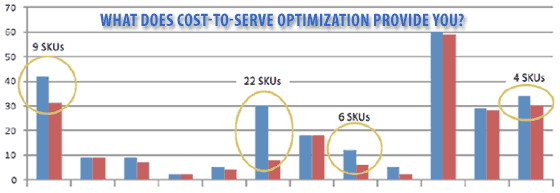What is Cost-to-Serve Optimization?
Cost-to-Serve is the analysis and quantification of all the activities and costs incurred to fulfill customer demand for a product through the end-to-end supply chain.
Latest Logistics News
Following USTR review, White House announces tariff increases on certain U.S.-bound imports from China Inflation continues to have a wide-ranging impact on supply chains, notes Blue Yonder survey National diesel average decreases for the fifth consecutive week, reports EIA New Union Pacific service connects Southern California and Chicago STB Chairman Martin J. Oberman retires More NewsYour ultimate goal is to increase company profitability—either making unprofitable customers profitable, or making profitable customers more profitable! If you don’t know an accurate Cost-to-Serve for current customers and products, you can’t even get started improving profitability.
There are multiple methods and disciplines to achieve this, and the distinctions between them are not always clear. The terms “Activity-based Costing” (ABC) and “Costto-Serve Analysis” (CTSA) are used to describe two different cost modeling approaches, both of which require allocating indirect costs to cost drivers in a process or supply chain model. Further, Supply Chain Network Design and Cost-to-Serve Optimization are both supply chain optimization disciplines that can identify and reduce costs and increase profitability.
So which do you use where and for what?
A starting point for understanding the two different methods is the recognition that Activity-based Costing is not Cost-to-Serve, but ABC utilizes a similar approach to CTS. Both methods center on allocating indirect cost pools to products—overhead or fixed costs that are not easily and directly attributable to a single order, shipment, or activity. Both also seek to make clear the “invisible” costs in the process or network being examined. However, the use, context, and level of detail of the two methods are different.
 When a client conducted an analysis on their product and source point portfolio, it resulted in 41 SKUs being discontinued at specific source points due to excessive costs (from the LLamasoft White Paper on Cost-to-Serve Optimization)
When a client conducted an analysis on their product and source point portfolio, it resulted in 41 SKUs being discontinued at specific source points due to excessive costs (from the LLamasoft White Paper on Cost-to-Serve Optimization)Activity-based Costing is often used by the finance department to cost out and predict the budget of departments, processes, or business activities under changing loads of cost drivers. Without an ABC model, the financial impact of product mix and volume changes can be misunderstood and the wrong decisions made. It helps finance focus on total product costs within the four walls of the organization. ABC identifies all of the relevant activities in a process or organization of interest, then identifies a natural cost driver, such as labor hours, or product quantity, which can be related to an indirect cost pool.
By making a detailed model of all the value and non-value added activities performed in the process, and connecting the activity drivers more directly to all of the relevant cost pools, the resulting cost model is much more precise than other more traditional methods for determining “what-if” budgets. ABC is very detailed and time-intensive to prepare. It is typically used to supplement traditional cost accounting methods to analyze specific financial decisions. ABC is not typically applied to an end sales item at the point of transfer to the customer.
Cost-to-Serve has a scope across all functional areas in the supply chain and is intended to accurately assess the total profitability of an individual product or item being sold to a customer. CTS models and incorporates all activities necessary to complete the customer delivery and collect the product revenue. It models how each major supply chain activity affects the complete end-to-end cost-to-serve a customer or total landed cost for a product. Stated differently, it is the determination of the total cost of servicing each individual customer at an SKU level, and at the designated level of service.

Article Topics
Latest in Logistics
Following USTR review, White House announces tariff increases on certain U.S.-bound imports from China Insider Q&A: Improving Freight Transportation: Anticipate scenarios, mitigate disruption, think long-term Inflation continues to have a wide-ranging impact on supply chains, notes Blue Yonder survey National diesel average decreases for the fifth consecutive week, reports EIA New Union Pacific service connects Southern California and Chicago Automate and Accelerate: Replacing Pick-to-Light with the Next Generation of Automation STB Chairman Martin J. Oberman retires More LogisticsSubscribe to Logistics Management Magazine

Find out what the world's most innovative companies are doing to improve productivity in their plants and distribution centers.
Start your FREE subscription today.
May 2024 Logistics Management

Latest Resources














